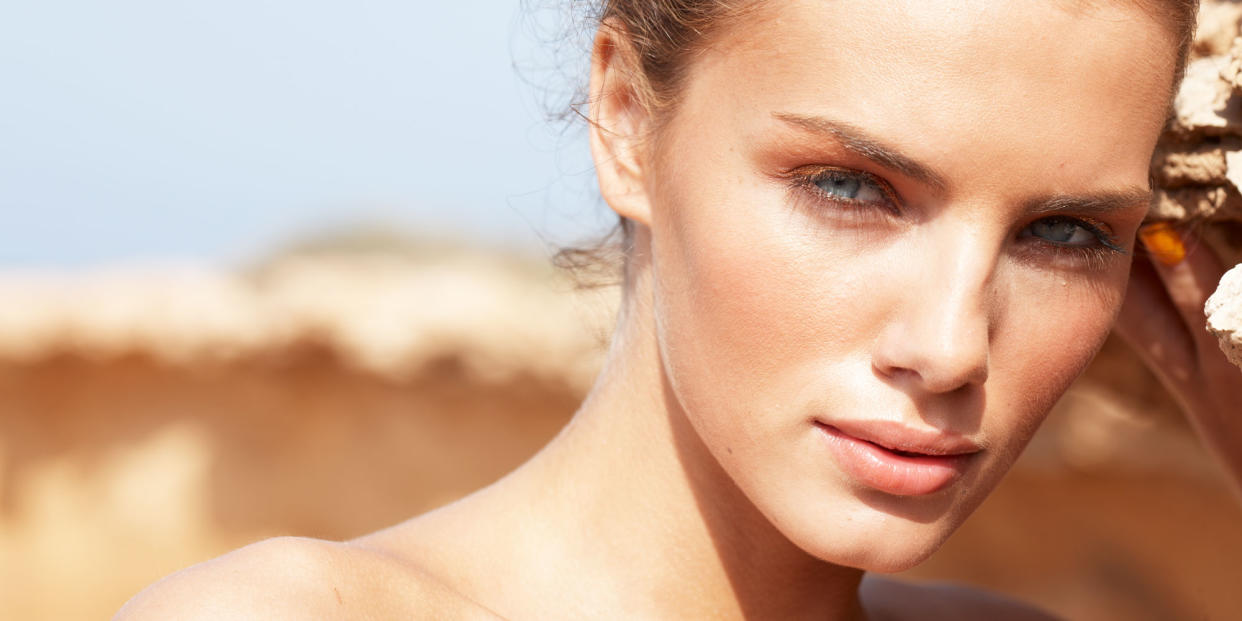10 Things You Need to Know About Rosacea

There's a high chance that if you're reading this, you think you have rosacea, a disorder that affects 16 million Americans, according to the National Rosacea Society (NRS), and is characterized by facial redness (caused by overactive blood vessels under the skin that dilate and cause flushing), red bumps, and pus pimples," explains Joshua Zeichner, MD, a cosmetic dermatologist in NYC. So, to gain a greater understanding of the disorder - and in honor of National Rosacea Month (hey, April!) - here's everything you need to know about this redness-inducing skin condition.
1. If your mom or dad has rosacea, you probably do too. There is definitely a genetic component to this disorder - you either have it or you don't. If you don't have it in your genes, you can never get it. But if you do have it, according to Dr. Zeichner, your genetic makeup determines whether your condition will be mild or more severe.
2. Rosacea is most commonly diagnosed in people with fair skin. While rosacea can affect any skin tone, it's more commonly diagnosed on lighter skin types, since the initial flushing (on the nose, cheeks, or chin) is more clearly visible. "That said, if you have a darker skin tone and have noticed a ruddiness or pink tone to your complexion that isn't going away, talk to your dermatologist so he or she can properly diagnose and address the issue," Dr. Zeichner suggests.
3. Initial symptoms can be mistaken for sensitive skin or acne when you're younger. When you're a teenager or twentysomething, rosacea's signature flush can appear to be sensitive skin, turning your skin a subtle pink shade. Rosacea's pus-filled bumps (aka acne rosacea) that show up on the central part of the face can also be mistaken for acne (aka vulagaris, the result of bacteria, dirt, and oil mixing together, which clogs your pores). Early detection is especially important in this case, because treating acne rosacea the same way you would acne vulgaris will definitely exacerbate your disorder, drying it out further and increasing redness without eradicating the pimple-like bumps.
4. Symptoms tend to get worse with time if left untreated. As soon as you think you might have rosacea, get it checked. Here's why: "Rosacea can become more severe over time, so if you ignore early warning signs, like prolonged flushing, it will be harder to reverse the redness," Dr. Zeichner says. Cases can even become so extreme (as you age) that "the nose may grow swollen and bumpy from excess tissue - a condition, called rhinophyma," according to the NRS. Not to mention, your eyes can also be affected, looking and feeling irritated and bloodshot.
5. It's not curable. "While the exact cause of rosacea is unknown, and the disorder itself remains incurable, you can help keep it under control and prevent it from progressing with topical products, which all have anti-inflammatory, soothing ingredients," Dr. Zeichner says. There are oral medications you can also take, like Oracea, a low-dose antibiotic that's used as an anti-inflammatory. "Luckily, the dose is so low that it doesn't have an antibiotic effect, so you can use it for long periods of time without developing bacterial resistance," he adds.
6. Using products that replenish hydration will help calm an inflamed complexion. "Since patients with rosacea have a dysfunctional skin barrier that also doesn't maintain hydration as well as it should," Dr. Zeichner says, "you want to be sure you're not using harsh cleansers." This means avoiding face wash with physical exfoliants (jojoba beads or crushed seeds used to slough away dead skin cells) and chemical scrubs (think glycolic, salicylic, and lactic acids), and alcohol-based toners. Instead, he suggests opting for hydrating formulas, like Neutrogena Ultra-Gentle Hydrating Cleanser or L'Occitane Shea Butter Cleansing Milk to cleanse (and calm!) your skin.
7. Sun exposure will make your rosacea worse. Whether you have a mild or severe case, ultraviolet (UV) exposure will bring on a rosacea flare. So Dr. Zeichner recommends wearing daily sun protection of 30 and above and, because rosacea patients tend to have sensitive skin, he suggests picking up a physical sunblock (they contain zinc oxide and titanium dioxide), since chemical-containing sunblocks can cause irritation in rosacea patients. Try Promise Organic SPF 30 Coconut Sunscreen Lotion and La Roche-Posay Anthelios 50 Mineral Ultra Light Sunscreen Fluid.
8. There are a ton of factors that trigger rosacea flares. "Anything that makes your face flush is essentially a rosacea trigger," Dr. Zeichner says. Specific ones include: stress, spicy foods, alcohol (particularly red wine), hot beverages, and extremes in weather, like hot to cold or cold to hot. For more, click here. Don't want a flare-up? Skip that jalapeño margarita.
9. The FDA just recently approved a brand-new drug to treat rosacea. Rhofade, a 1 percent prescription-strength cream (launching in May!), has been proven to minimize the flushing associated with persistent rosacea by constricting the blood vessels through a 12-hour period. So if you deal with persistent redness, ask your dermatologist if the formula is right for you.
10. Lasers can help minimize the overall redness caused by rosacea. The V-Beam laser, an example of a pulsed dye laser, works by releasing pulses of light that penetrate the skin and destroy the abnormal blood vessels, significantly minimizing the redness. While the laser doesn't get rid of the rosacea entirely (again, it's incurable), your skin tone will look more even after one treatment. In more severe rosacea cases, additional treatments may be needed (anywhere from three to eight sessions) every three-to-four week period. Expect costs to range between $400 and $600 per session, depending on where you live.
Get non-boring fashion and beauty news directly in your feed. Follow Facebook.com/CosmoBeauty.
Follow Carly on Twitter and Instagram.
You Might Also Like

